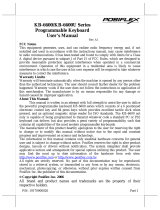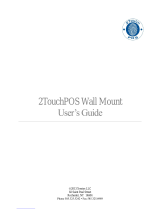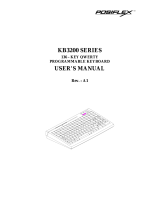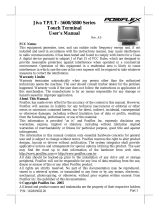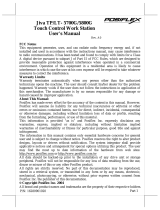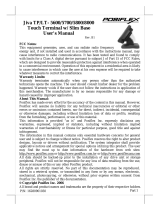Page is loading ...

FCC Notes:
This equipment generates, uses, and can radiate radio frequency energy and, if not installed and
used in accordance with the instructions manual, may cause interference to radio communications.
It has been tested and found to comply with limits for a Class A digital device pursuant to subpart
B of Part 15 of FCC Rules, which are designed to provide reasonable protection against
interference when operated in a commercial environment. Operation of this equipment in a
residential area is likely to cause interference in which case the user at his owns expense will be
required to take whatever measures to correct the interference.
Warranty Limits:
Warranty terminates automatically when any person other than the authorized technicians opens
the machine. The user should consult his/her dealer for the problem happened. Warranty voids if
the user does not follow the instructions in application of this merchandise. The manufacturer is by
no means responsible for any damage or hazard caused by improper application.
About This Manual:
Posiflex has made every effort for the accuracy of the content in this manual. However, Posiflex
Technology, Inc. will assume no liability for any technical inaccuracies or editorial or other errors
or omissions contained herein, nor for direct, indirect, incidental, consequential or otherwise
damages, including without limitation loss of data or profits, resulting from the furnishing,
performance, or use of this material.
This information is provided “as is” and Posiflex Technology, Inc. expressly disclaims any
warranties, expressed, implied or statutory, including without limitation implied warranties of
merchantability or fitness for particular purpose, good title and against infringement.
The information in this manual contains only essential hardware concerns for general user and is
subject to change without notice. Posiflex Technology, Inc. reserves the right to alter product
designs, layouts or drivers without notification. The system integrator shall provide applicative
notices and arrangement for special options utilizing this product. The user may find the most up
to date information of the hardware from: http://www.posiflex.com or http://www.posiflex.com.tw
or http://www.posiflexusa.com
All data should be backed-up prior to the installation of any drive unit or storage peripheral.
Posiflex will not be responsible for any loss of data resulting from the use, disuse or misuse of this
or any other Posiflex product.
All rights are strictly reserved. No part of this documentation may be reproduced, stored in a
retrieval system, or transmitted in any form or by any means, electronic, mechanical, photocopying,
or otherwise, without prior express written consent from Posiflex Technology, Inc. the publisher of
this documentation.
© Copyright Posiflex Technology, Inc. 2013
All brand and product names and trademarks are the property of their respective holders.
KP-500
MULTIFUNCTION
SECURITY DEVICE
USER’S MANUAL
Rev.:
original
P/
N:
18420900010

Page 2
ALERT TO OUR HONORABLE CUSTOMERS:
Please always read thoroughly all the instructions and documents delivered
with the product before you do anything about it. Don’t take any premature
action before you have a full understanding of the consequences.
DAILY MAINTENANCE GUIDE
For regular cleaning of the KP systems, please use only soft haired brush or
dry soft cloth. You may use moist soft cloth to remove stains when necessary.
Apply only suitable amount of mild neutral cleaner for obstinate stains. Please
note that never use Acryl dissolving solvent or Polycarbonate dissolving
solvent. You may apply ammonia-based glass cleaner only on the screen
surface.
GENERAL DESCRIPTION
KP-500 is 40 keys upgrade kit for Posiflex POS terminal 15” XT series. 24
programmable keys with 16 predefined keys place a convenience side mount
input device for pleasant user experience.
INSTALLATION
For KP-500 w/o SA-104 to install in the 15” XT series, please
arrange the XT’s main unit on a flat surface and unfasten these
screws which are circled in the right picture to release the
cover.
There are 2 connectors which you may find after the cover
released and please gently connect the cable to one of the 2 white
connector which are inside the side cover of KP-500 as shown in
the right picture.
After connecting this cable, please hold the KP-500 and join
to the XT main unit and as arrowed in the right picture.
After matching the KP-500, please use the original
screws to fasten the keypad. Please reserve the cover
if there is a possibility to remove the side mount
upgrade kit.

Page 3
KEYTOP LAYOUT
Keytop Replacement
The keypad in KP-500 is organized into 2 parts: a 4 X 4 numerical keypad area
and a 4 x 6 square programmable keypad area.
Conversely, this keypad allows some layout alterations by the system
integrator. Besides the standard single key installed, there are double keys and
blank keys for purchase to provide more convenient user interface.
When replacement of keytop is required, it is advisable to use a flattop (minus
sign) screw driver (Do not use the attached key clip for this operation.) to help
getting the key top off gently. Please always first orientate the key tops as
below before inserting any keytop into the case of the keypad. Failure to do so
could result in permanent damage not covered in product warranty.
Please always match the latching tab on bottom stem of keytop with the tab in
guiding hole and gently press the key top down till a click sound is heard as
indicated in the pictures below.
Labeling On Keytop
The programmable keypad is provided with easy and durable methods for
reminding the user of content programmed in each programmable key. First
preprint (or write) in each cell of the attached colored sheet the “name” for
each key. Stick each cell to the corresponding keytop and then put on the
transparent key cap from the accessories. In this way, the labeling will be
protected and resistant to scratch or rubbing.
When re-labeling is required, please use the attached key clip to hook up the
transparent key cap and change the label then re-cap.
KEYPAD PROGRAMMING
The programming of the keys above the numerical keypad in KP-500 is in

Page 4
general the task of the system integrator and not the average end user. For end
user, please go to the chapter of “OPERATION GUIDE” of this manual
directly.
Utility Installation
In the Posiflex Product Information CD attached with KP-500 or please
download from our web site: http://www.posiflex.com the keypad
programming utility for KP-500.
Please select the right model when entering the program if questioned by the
program.
Keypad Programming
A normal keyboard may be required for inputting data in keypad programming.
In the command menu of the programming utility, “Keyboard” => “Read” or
“Write” can be used to transfer the current content in KP-500 to the program
memory or vice versa. “File” => “Open” or “Save” can be used to edit an
existing template file or preserved the current program content to a template
file. “View” command alters the key map page corresponding to the position
of control key. The rightmost column in key map for Page 1 refers to the
answer back codes for the control key.
Right click (or left click to select a key and followed by a “Return” key of
normal keyboard) in the key map to start editing the selected key. Select
another key or press “Down Arrow” of normal keyboard finishes programming
of that key. Remember to “Keyboard” => “Write” or “File” => “Save” before
exiting the program otherwise everything worked will be lost.
Quick Reference Guide for Programming a Key
Please refer to our web site for every detail in programming the programmable
keyboards or keypads. The following simplified guide severs as a concise tool
for instant application.
Keys to Program How to Program Them
Esc, Enter, Tab, Back Space, Caps
Lock, Menu, Window, F1 - F12,
Shift, Ctrl, Alt, Arrow Keys and
All Functions like: Print Scrn,
Scroll Lock, Pause, Insert, Delete,
Home, End, Page Up, Page Down
Right click in the key editing area
and select the desired key from the
menu/submenu appeared
A - Z, 0 -
9, ~ ` ! @ # $ % ^ & * ( )
Press: “Desired Key or Keys” of the

Page 5
- _ = + } { [ ] | \ ’ ; ” : /. , < > ? normal keyboard
Hardware Limitation in Programming
In case of “multiple combination key” application which means pressing three
or more keys at the same time to obtain certain data output from the keypad,
there could be some limitations inherent from the nature of keypad structure.
The CPU of keypad detects the contact between the “horizontal” and “vertical”
lines for each key press, recognizes which key is pressed and sends
correspondent data to the host computer. When there are many keys pressed at
the same time, and the pattern of the contacts coincides with some special
relationship, there are chances that the CPU of keyboard be confused about
exactly which keys are pressed. The user may change the locations of the key-
definition to prevent this once such confusion happens.
OPERATION GUIDE
MAGNETIC STRIPE READER
The SA-104 MSR with KP-500 series reads an ISO magnetic stripe card
without additional device driver and its icon can be viewed accordingly in
Windows Device Manger program. For magnetic stripe card reading, be sure
to insert the card to the bottom with magnetic stripe facing the mark aside the
slot. The movement of the card can be either inserting the card from the top
surface then sliding the card down out of the slot, or sliding the card upward
from the lower side of the slot till it reaches the top end as long as the card is a
standard one. A non-standard card recorded without complete degaussing prior
to recovery may accept only one direction in card reading.
RF310 USB RFID Reader
The RF310 USB RFID reader is a radio-enabled USB interface reader device
that emulates a USB HID keyboard mechanism for communication between
both a RFID MiFARE card and a host system. Without write-in behavior, the
reader and MIFARE card are synced to work or to be sensored within the RF
range. The minimum contact range should not be over 2 cm.
T31454
/
